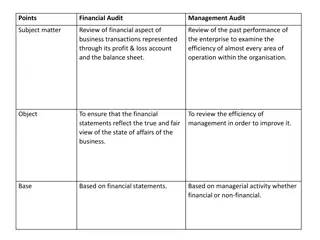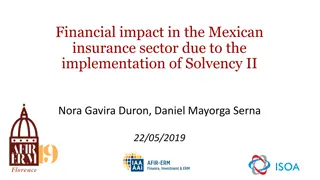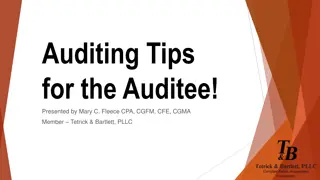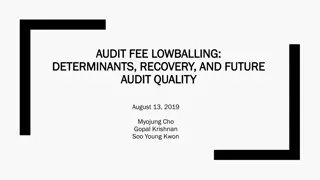Continuous Audit at Insurance Companies
Creating a rule-based model for anomaly detection, this research focuses on developing an architecture for continuous audit systems. By utilizing historical data, the scope includes detecting fraud, discrepancies, and internal control weaknesses, leading to a maturity model for automated continuous audit and monitoring. The method involves an evolving framework for continuous risk monitoring, assessment, and control, with steps in the forensic and audit process outlined. The framework includes steps such as identification of the system, data capture, cleaning, KPI creation, scenario testing, exception examination, risk profiling, and setting up audit mechanisms.
Download Presentation

Please find below an Image/Link to download the presentation.
The content on the website is provided AS IS for your information and personal use only. It may not be sold, licensed, or shared on other websites without obtaining consent from the author.If you encounter any issues during the download, it is possible that the publisher has removed the file from their server.
You are allowed to download the files provided on this website for personal or commercial use, subject to the condition that they are used lawfully. All files are the property of their respective owners.
The content on the website is provided AS IS for your information and personal use only. It may not be sold, licensed, or shared on other websites without obtaining consent from the author.
E N D
Presentation Transcript
Continuous Audit at Insurance Companies Youngbum Kim, PhD. Student, Rutgers Univ. Sutapat Thiprungsri, PhD. Student, Rutgers Univ.
Outline Objectives Scope Methods Research Framework A Rule-based model for Anomaly Detection Clustering Q&A 2
Objectives Creating an architecture for a future continuous audit of the systems in question Assisting the audit with analytical support Creating system specific filters of eventually preventive nature 3
Scope Historical disbursements & claims data to develop filters that may detect fraud, discrepancies and internal control weaknesses Maturity Model Automated Continuous Audit Continuous Control Monitoring 4
An evolving continuous audit framework Continuous Risk Monitoring and Assessment Automation Sensoring Continuous Data Audit Continuous Control Monitoring ERP E-Commerce Continuous Audit
Steps in the continuous forensic and audit process 1. Identify system and understand its structure and features 2. Capture relevant data 3. Clean and scrub data 4. Create KPI and extraction models 5. Run models under different scenarios 6. Examine the exceptions found on an interactive basis 7. Decide on profile of risk 7
Cont. 8. Place filters in the entrance of processes 9. Create an audit by exception mechanism within the internal audit organization 10.Create interfaces between management continuous monitoring and audit by exception 11.Continue the forensic model development process based also on the filtering results 12.Work on external audit reliance on the process 8
A Rule-Based model for Anomaly Detection 10
Research Question Prior Research Focuses on fraud by outsiders such as customers, criminals, and intruders ( external fraud). Little research on Internal Fraud Highly depends on labeled/classified data. Known internal fraud examples are rarely documented and disclosed. Unsupervised method of profiling Practicability Rarely considers actual implementation by internal auditors Rule-based indicators and suspicion scoring system How can we develop a rule-based model to detect abnormal (internal fraudulent/erroneous) wire transfers? 11
Obstacles to Anomaly Detection Anomaly (including internal fraud) detection When anomaly prevention fails (how to know?). Detects in a timely manner (or at least not too late, especially for internal fraud). Too small number of anomaly cases. Continuous Auditing/Monitoring process Unawareness that the anomaly prevention control has failed. Highly adaptive existing fraudsters (=fraud perpetuators) and New comers. Cost of undetected anomaly (esp. internal fraud) is significant. 12
Model Development Process Information collection Discussion with Internal Auditors for Validation Result Investigation by Internal Auditors Rule Creation (addition/deletion/revision) Model Testing with Data (Re-testing) Note. ( ): After the first round 13
Anomaly Detection Process A transaction Anomaly detecting model Suspicion Score Calculation N Greater than criterion? No Reports Y Labeled as potential anomaly Test of detail by internal auditors Final Results 14
Indicators Category 21types (38 indicators) of anomaly indicators. Purport to identify abnormally low or high values, abnormally positive slope, or abnormally different from population norms. Conditional tests Pass/Fail or Yes/No types Some of them are directly related to controls. Statistical tests PI/CI, Frequency test, Correlation test, or Clustering Developed by using either prediction intervals, correlation, or clustering. 15 15
Anomaly Indicators: Example (Note. All the examples are fictitious.) Questions Questions Possible Filtering rules to test Possible Filtering rules to test The payee transactions payment amount is out of the range of payment amounts. Amount range for each payee (or all payees) & check outliers. The payee transaction payment trend line over time has a positive slope. Correlation between date (or sequence numbers) and payee amounts for each payee The payee is an outlier to payee baseline activity. (Send to a payee that normally do not send to) Payee frequency by each initiator & check the payees that have the least frequencies. The transaction amount is out of range of normal activity from this bank account. The 90, 95, and 99 PI amts for each sending/receiving bank account and check the exceptions. The transaction initiator is not a normal sender from this bank account. First, check the list of sender bank account, then create exception list of initiators by sending bank account. The transaction payee is not a normal receiver from this bank account. A list of payees by sending banks who have least frequency: 16
Suspicion Scores (All the numbers are fictitious.) Statistical score 0 1 2 3 4 5 6 Total score 0 1 2 3 4 5 6 7 All wires Last Qtr only All wires Last Qtr only 197505 7943 1867 762 150 12 2 52574 2092 485 281 92 10 4 81922 101384 17596 5772 1072 384 83 21 32666 18227 2824 1425 266 84 32 7 Conditional score 0 1 2 3 4 5 6 7 All wires Last Qtr only 8 5 5 86613 102686 14063 4327 402 133 15 2 34472 17787 2183 987 80 22 3 4 10 2 2 If Target Flags are between 25 and 30, 5 for Statistical, 6 for Conditional, and 7 for Total scores. 17
Examples of Flagged Wires Statistical score Conditional score Total score wireID amount 10 25 33 42 50 52 63 950,000 22,600,000 4,000 11,500,000 8,200,000 600,000,000 85,000,000 5 5 0 5 2 3 6 0 1 6 2 5 5 7 5 6 6 7 7 8 13 18
Contribution Proposes developing a detection model of internal fraud with unlabeled/unclassified data. Describes the development process of an anomaly detection model that is implementable by internal auditors. Shows that developing process of anomaly detection model can help internal auditors to identify weakly-controlled areas and thus provide additional assurance. 19
Limitations and Future Study Limitations False negatives may exist in model development. Some anomaly indicators may not be applicable to the other companies. Future Study Needs more fine-tuning, that is, specification and customization to consider transactional characteristics. Thus, Next step will examine the relevance of relevant attributes. If relevant and effective, they will improve the current model. 20
Clustering For Anomaly Detection 21
Insurance Claims Objective To detect potential fraud or errors in the claims process by using clustering techniques Steps in Cluster Analysis Selecting attributes Selecting distance measurement Selecting cluster techniques Analyzing the resulting clusters Identifying anomaly and/or outliers 22
Visualizing combination of attributes, we will be able to see similarity and differences among claims 23
Analyzing individual variables, we will be able to see clearly that some claims have rare values 24
Contribution Clustering can be used to build a model for anomaly detection when the labeled data are not available. It may help to discover some hidden pattern or clusters in the dataset. 25
Limitations and Future Study Cluster Analysis always generates clusters, regardless of the properties of the data-set. The interpretation of the results might not be clear. How to define anomaly could also be a problem. 26
Thank you for your attention! 27
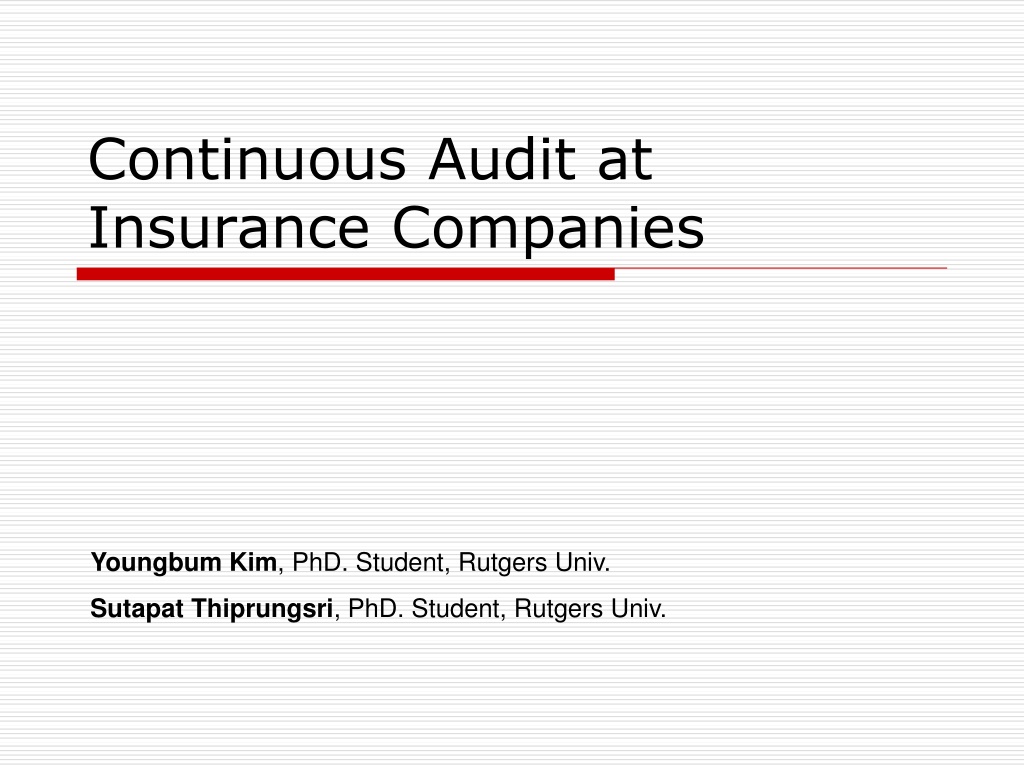
 undefined
undefined











